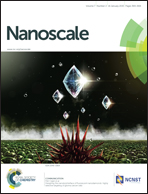Formation of core–shell-structured Zn2SnO4–carbon microspheres with superior electrochemical properties by one-pot spray pyrolysis†
Abstract
Core–shell structured Zn2SnO4–carbon microspheres with different carbon contents are prepared by one-pot spray pyrolysis without any further heating process. A Zn2SnO4–carbon composite microsphere is prepared from one droplet containing Zn and Sn salts and polyvinylpyrrolidone (PVP). Melted PVP moves to the outside of the composite microsphere during the drying stage of the droplet. In addition, melting of the phase separated metal salts forms the dense core. Carbonization of the phase separated PVP forms the textured and porous thick carbon shell. The discharge capacities of the core–shell structured Zn2SnO4–carbon microspheres for the 2nd and 120th cycles at a current density of 1 A g−1 are 864 and 770 mA h g−1, respectively. However, the discharge capacities of the bare Zn2SnO4 microspheres prepared by the same process without PVP for the 2nd and 120th cycles are 1106 and 81 mA h g−1, respectively. The stable and reversible discharge capacities of the Zn2SnO4–carbon composite microspheres prepared from the spray solution with 15 g PVP decrease from 894 to 528 mA h g−1 as current density increases from 0.5 to 5 A g−1.


 Please wait while we load your content...
Please wait while we load your content...